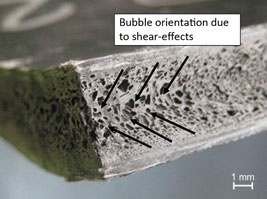Topic of the work:
Physically foamed thermoplastic injection moulded components have many advantages over compact components. Due to the foam structure, a significant weight reduction is achieved for the same volume, which results in a large potential for lightweight construction. Furthermore, shrinkage and warpage are reduced by the pressure of the blowing agents in the cells. For these reasons, the demand for foamed plastic components is continuously increasing in the course of resource efficiency and ever higher technical requirements.
Current simulation programs make numerous simplifications when calculating the foam structure, so that phenomena such as shear-induced cell orientation or the merging of two small cells into one large cell (coalescence) are not taken into account. As a result, foamed technical components cannot be designed today on the basis of simulations alone.
Goal:
The goal of your work is to build a first simplified simulation model in OpenFOAM, which calculates the cell structures on a microscale level for given boundary conditions (e.g. local shear rate, pressure, as well as temperature and viscosity). There are already several physical models identified, that you can use.
Your tasks:
Within the duration of a Bachelor’s Thesis, you will work on following tasks:
- Generation of boundary conditions for a given test geometry
- Development and implementation of a physical microscale model to describe the foam structure
Within the duration of a Masters’s Thesis, you will work on following tasks:
- Set-up of an injection moulding simulation in OpenFOAM (OpenInjMoldSim) and generation of boundary conditions for the microscale model
- Implementation of a physical microscale model to describe the cell distribution
- Validation of the foam structure in practical tests using computed tomography
Your profile:
- Technical studies (e.g. mechanical engineering, computer science, CES)
- Basic knowledge of programming
- Interest in FEM simulations
Get in touch, if you are interested in working on a fundamentally new approach to foam simulation. I am looking forward hearing from you!
Your contact:
Cemi E. Kahve, M.Sc. RWTH
Telefone: +49 241 80-96621
E-Mail: cemi.kahve@ikv.rwth-aachen.de

